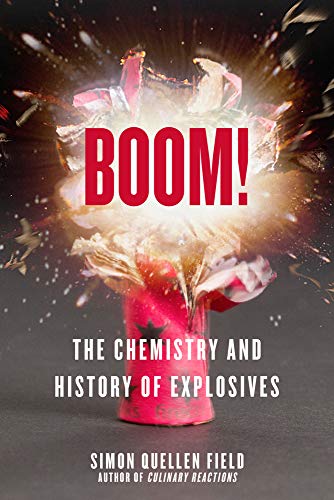Boom!
The Chemistry and History of Explosives
Simon Quellen Field
BOOK REVIEW

In a world where the sound of an explosion can elicit both awe and terror, Boom!: The Chemistry and History of Explosives by Simon Quellen Field stands as a riveting exploration of humanity's volatile relationship with explosives. This book doesn't just scratch the surface-it detonates deep into the chemistry, history, and societal impact of substances that have shaped wars, industries, and even the very fabric of modern life.
From the ancient Chinese alchemists concocting early fireworks to the precision-guided munitions of today, Field takes readers on a thrilling ride through time. It's not merely a technical manual or a dry academic text; it's an invitation to peer into the explosive heart of human ingenuity and folly. His passion is palpable as he unpacks complex scientific principles in a manner that is both accessible and engaging. You will find yourself captivated by tales that intertwine human curiosity with the destructive power of chemistry.
💥 As you delve into the book, the historical narratives unfold like a tightly wound fuse nearing its end. Field recounts pivotal moments-from the invention of dynamite by Alfred Nobel, whose personal struggles with the ramifications of his creation led to the establishment of the Nobel Prizes, to the infamous use of explosives during World War II that shifted the tides of battle. Each chapter crackles with energy, as if the very pages could explode with the weight of the stories they hold.
Yet, this is more than a mere chronicle of explosions; it's a reflection on the duality of power. When you contemplate the enormous energy harnessed for both construction and destruction, you can't help but feel a chill. Field masterfully illustrates how societal perceptions of explosives have evolved, morphing from celebratory spectacles to symbols of fear and destruction. It prompts a profound question: In pursuing progress, at what cost do we wield such destructive power?
Readers are left grappling with these questions, and that's where Boom! truly excels. Critics have praised Field for his ability to blend scientific rigor with compelling storytelling, though some have pointed out moments where the technical details may overload those without a chemistry background. However, for those who dare to embrace the complexities, the rewards are immense. Comments from readers highlight a sense of discovery-how learning about the elements of explosives has reshaped their view on safety, construction, and even daily household items.
⚠️ Some voices in the crowd argue that the book delves too deeply into the technical aspects, making it a challenging read for those looking for a lighter touch. Nonetheless, for the scientifically inclined or the history buff, Field's detailed approach reveals the intricate dance between chemistry and human ambition. It's a reminder that knowledge can be both enlightening and dangerous.
As Boom! bombards you with facts, figures, and heart-pounding anecdotes, the exhilarating pull of knowledge ignites a fire within. This work is an essential reading not only for students of science but for anyone fascinated by the ripples of innovation through history. The resonance of explosives isn't confined to the battlefield; it echoes in our industries, our celebrations, and in those quiet moments of invention.
💣 So, what do you do with the knowledge that you've gained? That's entirely up to you. Perhaps you'll ponder your surroundings with a newfound appreciation for the delicate balance of chemistry that sustains your daily life. Or maybe, just maybe, you'll start to view the world through the lens of a chemist, seeking to understand the explosive potentials that lie within everyday occurrences. In the end, Boom! is not just a history lesson; it's a clarion call to explore, innovate, and, yes, even to explode-figuratively speaking, of course.
📖 Boom!: The Chemistry and History of Explosives
✍ by Simon Quellen Field
🧾 288 pages
2017
#boom #chemistry #history #explosives #simon #quellen #field #SimonQuellenField